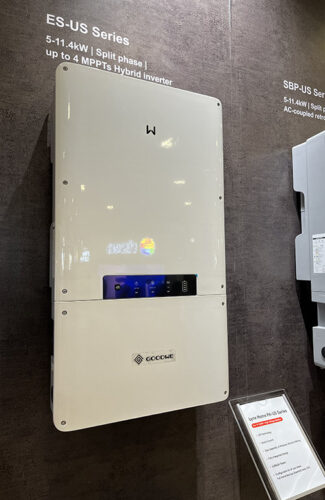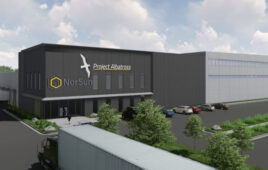At last year’s RE+ tradeshow in Anaheim, inverter manufacturers made vague statements about looking into U.S. manufacturing to help customers satisfy the IRA’s domestic content incentives. This year in Las Vegas, some of those loose plans have been solidified.
Here’s what I learned on the domestic manufacturing front at the U.S. solar industry’s biggest tradeshow, along with other new tech I saw in both small- and large-scale solar power electronics.

SolarEdge’s bidirectional EV charger.
SolarEdge announced it has started contract manufacturing operations with Flex in Austin, Texas. (Update 9/20/2023: SolarEdge’s head of corporate communications and global PR has since clarified that there was no intention to announce U.S. manufacturing operations at RE+).
The company is focusing its next generation of products on DC coupling. As homes move toward full electrification, from stovetops to cars, DC-coupled solar + storage systems cut down on energy losses along the way and squeeze out as much power as possible.
SolarEdge also highlighted its forthcoming bidirectional DC EV Chargers at RE+. This charger enables both solar-powered Vehicle-to-Home (V2H) and Vehicle-to-Grid (V2G) functionality. Customers can charge their EVs directly from rooftop PV without additional AC-to-DC conversion steps.

Enphase’s IQ Battery 5P, with and without the cover.
Enphase has all three of its U.S. contract manufacturing partners up and running — in South Carolina, Texas and Wisconsin. By later this year, the company plans to expand its IQ microinverter line to accommodate a wider variety of modules with various voltages. The company is also working on adding small commercial microinverters and bidirectional EV chargers.
Enphase also featured its IQ Battery 5P, an LFP solution with six IQ8 microinverters embedded inside. The 5P can now be ground-mounted and comes with a 15-year warranty.

Power Electronics’ PCSM inverter.
Central inverter-maker Power Electronics will soon start its own factory in Houston, Texas — beginning with EV chargers, then adding large central solar + storage inverters later on. At RE+, Power Electronics brought along both its flagship PCSM utility-scale MV battery inverter as well as its DC/DC converter for solar + storage applications.

EPC Power’s M solar + storage inverter.
U.S. manufacturer EPC Power is producing large-scale inverters at full capacity at its new factory in South Carolina, with the ability to scale up further according to demand. The company is focusing on its CAB storage + PV inverter now, but plans to launch a new “M” (for modular) solar and/or storage inverter in 2025. A spokesperson called the 500-kW unit the “world’s largest string inverter or smallest central inverter.”

A Siemens Blueplanet inverter with the cover removed.
Siemens recently announced U.S. contract manufacturing plans for Blueplanet string inverters starting in 2024 in Wisconsin. These inverters can be purchased as standalone or fully assembled on a skid and dropped onsite. The daisy-chained skids work well on hilly terrain and are targeted toward the community solar market.
Residential trends
In the residential solar inverter space, companies are working to integrate as much functionality as possible inside the inverter to cut back on extra components needed in the array.

SMA’s Sunny Boy Smart Energy Inverter and associated battery options.
SMA highlighted its Home Energy Solution, which includes a hybrid inverter with optional Backup Secure functionality. The new Sunny Boy Smart Energy Inverter can be paired with BYD and LG batteries for nighttime backup — and in mid-to-late 2024, with SMA’s own residential battery.

APsystems’ energy storage inverter and battery.
Microinverter manufacturer APsystems is bridging into new territory this year with its first residential storage solution and associated AC-coupled inverter, APstorage and ELS-5K. System owners can choose between back-up, self-consumption and peak valley time modes to dispatch the lithium batteries.

The Hoymiles hybrid string inverter.
Another microinverter manufacturer, Hoymiles, is expanding into larger power electronics with its release of a hybrid string inverter to the U.S. market. The HYS-LV-USG1 comes in 3.8 kW to 11.5 kW power classes and supports both DC- and AC-coupled solar projects paired with energy storage or generators.

Growatt’s SPH residential storage inverter and APX battery.
Growatt’s new SPH residential storage inverter includes built-in backup support and no additional accessories needed for switching controls. The inverter can switch to backup power in 10 milliseconds. The company also showed its APX HV modular LFP battery, with built-in optimizers and ability to soft-start to avoid energy surges.

Goodwe’s ES hybrid inverter.
Goodwe’s two new residential hybrid inverters offer options for either AC- or DC-coupled residential solar + storage systems. Like most other brands, these are compatible with either Goodwe’s own residential batteries or other major battery suppliers.

The Solis S6 inverter.
Solis released a new S6 hybrid energy storage inverter with the option to DC-couple to numerous lithium battery options. Customers can also choose to integrate EV chargers and generators into an S6 system. Solis is embracing an “open ecosystem” for the new release — giving customers more choice to build systems using different brands.

Tigo’s GO battery.
Tigo released its GO battery and inverter, a more modular upgrade from its previous offering. The company has made improvements to the associated fleet management software to speed up and simplify commissioning.
Tigo is also rolling out a training program called Green Glove service, where new installers get a direct Tigo contact to walk them through their first install.
Large-scale solar + storage electronics trends
Many inverter manufacturers this year are honing in on the commercial and community solar market, with string inverters tailored to projects <5 MW. Other companies are working on targeting the large utility-scale market with inverters that are more modular and field-serviceable than central inverters of the past.

Sungrow’s modular SG4400.
Sungrow’s new 1,500-V C&I string inverter features 12 MPPTs and built-in anti-PID and PID recovery functionality. These inverters include advanced grid support like Q at Night, which allows them to provide reactive power to the grid when called upon.
The company also offers one of the largest central inverters on the market, the SG4400, which is made up of four modular units that are field-replaceable in case of a fault.

Solectria’s XGI 1500 inverter.
Yaskawa Solectria’s 1,500-V string inverters are designed to work with First Solar thin-film modules by preventing PID and maximizing energy yield. A grounded DC input helps avoid PID, which thin-film modules are more susceptible to because of their higher voltage and material makeup.

CPS’s utility-scale string inverter.
CPS America has been a key player in the commercial space for some time, but the company has its sights set on expanding into the utility-scale string inverter market. CPS is currently focusing on its new line of 800-VAC equipment, like the 800-V Breaker Box that pairs with the company’s 250/275-kW string inverters.

NEP’s commercial string inverter.
NEP is another microinverter manufacturer branching into string territory. The company this week released the commercial NEPTUNE string inverter, which pairs with NEP’s rapid shutdown solution to give installers the option to use one brand for both functions.
That’s a wrap for RE+ 2023!





Tell Us What You Think!